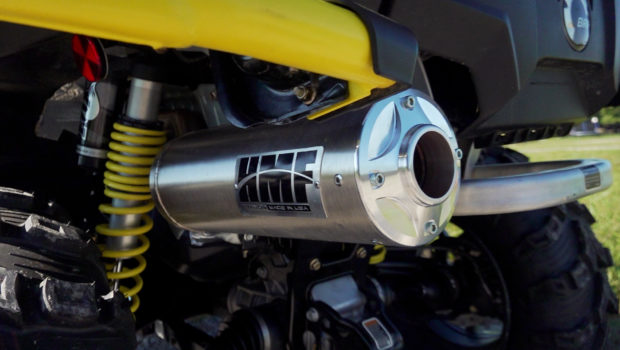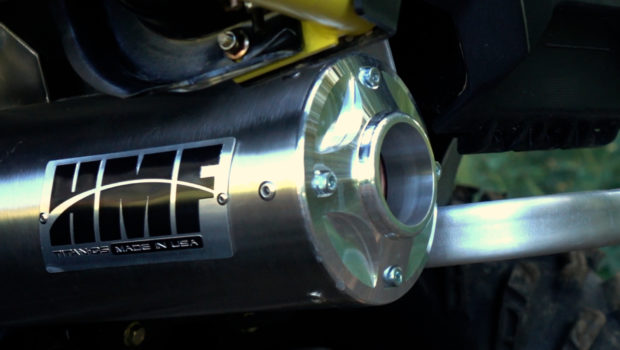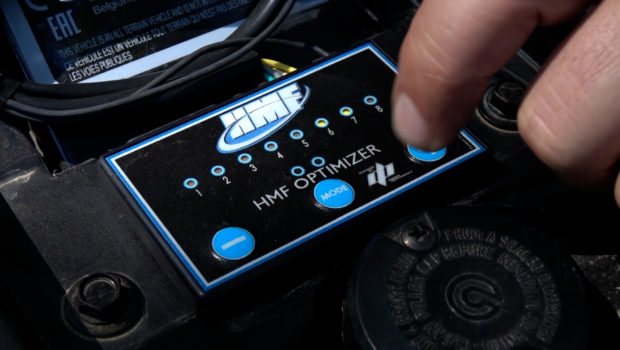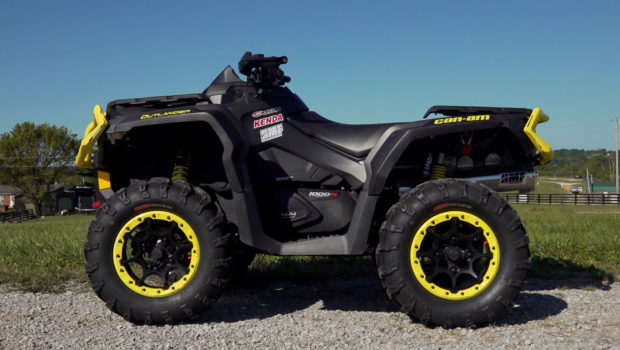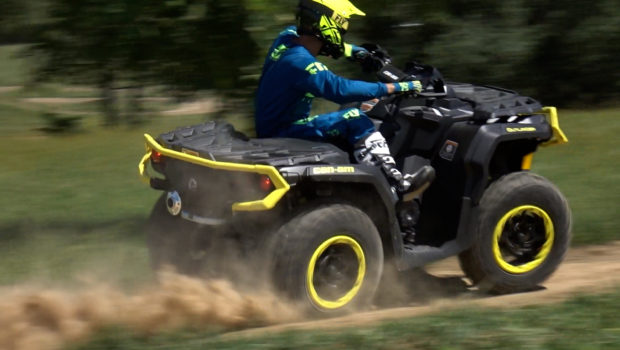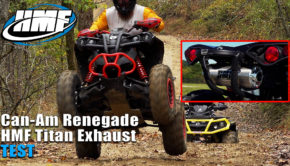Published on March 10th, 2022 | by Joe
HMF Can-Am Outlander 1000R Titan QS Exhaust and Fuel Optimizer Test Review
Based on the number of comments on our Can-Am Outlander test videos, there are a number of you out there craving even more horsepower from your 1-liter Rotax engine. We won’t lie. We’re trying to be careful with the throttle on the 1000cc Can-Am’s at times. But we also understand that when you’re trying to win a drag race against some guy on a hopped-up sport quad or one of those lumbering caged vehicles, a little more horsepower never hurts. It’s also a benefit when ripping big mud tires.
Construction
The easiest way to access more horsepower is typically by installing a good aftermarket exhaust and fuel controller. We often chose the HMF Titan Quiet Series for our 4×4 ATV builds and testing because they work to maximize horsepower gains while maintaining sound output typically within 2 to 3db of stock. Keeping sound down keeps riding areas open and more welcoming to ATV enthusiasts.
HMF’s Titan series exhausts are available in full systems from the header back, or as a slip-on system like the one we’ve been using. The Titan series is constructed of corrosion resistant stainless steel, utilizing a single 14” stainless steel silencer. The Titan’s silencer core and combination steel wool with glass pillow wool packing greatly reduces the frequency with which the silencer needs repacking, unless you frequently submerge it.
Definitive horsepower gains were hard to come by from HMF, telling us that typical horsepower gains are in the 10-15% range depending on if you go with a slip-on or full exhaust. The Titan QS sacrifices a small amount for its quieter sound output.
HMF’s Titan exhausts are available in a stainless steel finish, or can be blacked out with a black ceramic finish that does well at resisting staining and discoloring. We’d strongly consider adding it, especially if we were going with a full system as it helps dissipate heat under all the bodywork.
HMF’s freer flowing exhaust requires the addition of a piggyback fuel controller like the HMF Fuel Optimizer we installed or the more powerful Dynojet Power Vision, also available through HMF. Fuel Optimizer allows tuning of the air/fuel ratio sufficient for most riders. The Power Vision allows you to flash the ECU controlling fuel, timing, rev limits, fan temperatures and much, much more.
For racers or those operating on private land without neighbors near-by, you might want to look at HMF’s even freer flowing stainless steel Titan XL exhaust. You can save a few extra pounds by going with their Performance series which is constructed of stainless steel with an aluminum silencer which can be powder-coated a number of colors to match your machine. It can be ordered with a number of different end-cap styles and any part of the Performance Series can be blacked out. For serious mudders, HMF also offers their swamp Series. it’s constructed of stainless steel and can be ordered with a quiet or loud core. What sets it apart from the Titan series is an included, removable snorkel.
The Test
The slip-on HMF Titan exhaust and optimizer installed in a little over an hour our first time out. We did a little tweaking with the Fuel Optimizer during our 1000cc 4×4 shootout and a bit more leading up to our Outlander vs Renegade 1000 Shootout. We focused on the green, yellow, and red modes (Mode 1,2 and 3), which control fuel delivery at low, middle, and upper RPMs. HMF recommended settings of 3, 2 and 0 which seemed pretty close to ideal but we wound up going up to 4 on mode 1 which further eliminated hints of sputtering and minor popping on deceleration. It also made the engine run noticeably cooler both to our legs and in how much less the radiator fan was kicking on, especially in low-speed technical stuff. We found the rest of the RPM range to run cleanly but bumped the mode two settings from 2 to 3 and the mode 3 settings from 0 to 1 just to make sure we were getting plenty of fuel and cooler-running throughout without risking giving up much power by going too rich. HMF has helpful tuning videos on YouTube when you’re ready do some testing and tuning.
A “seat of the pants” feel, low RPM power feels similar to stock. When the hard hitting Rotax V-twin and snappy clutching already have you carefully regulating the throttle at low RPMs, subtle differences in performance are a little harder to pick up on. The gains were most noticeable in the midrange. As speeds begin to pick up and the front-end settles, our riders noticed a bit more potency when they squeezed the throttle. It’s beneficial when lightening the front end for bumps in the trail at speed, accelerating out of corners, pulling long hills, or when putting another machine in its place. Any gains in top-end power felt less pronounced, but every bit as impressive as stock. Running a full Titan QS or switching over to a Performance or Titan XL could yield more noticeable gains on top.
Conclusion
We came away feeling better about piping the Outlander 1000R than we originally expected. We made more power that we could feel, and our quad ran cooler which will translate into longer life.
Choosing the Titan Quiet, we went with maximum power gains with minimal additional sound output. While our choice to use the less expensive slip-on version could have left a little more horsepower on the table, we still enjoyed more power out of the Outlander 1000R focused in the area of the power curve where the rider can best make use of it.
With only complements on the deep throaty sound of the Titan QS, you’ll at least retain the appearance of sensibility as you make your Rotax even more insanely fun to ride. If you want to throw sensibility out the window and experience even greater gains than us, HMF has you covered there as well.
For more information on HMF exhausts and Fuel Optimizers log on to HMFracing.com
HMF Can-Am Outlander 1000R Titan QS Slip-On Exhaust: $489.95
HMF Fuel Optimizer: $319.95
HMF Outlander 1000R Titan QS Exhaust and Fuel Optimize Test Ratingr Final
Summary: We came away feeling better about piping the Outlander 1000R than we originally expected. We made more power that we could feel, and our quad ran cooler which will translate into longer life. Choosing the Titan Quiet, we went with maximum power gains with minimal additional sound output.

